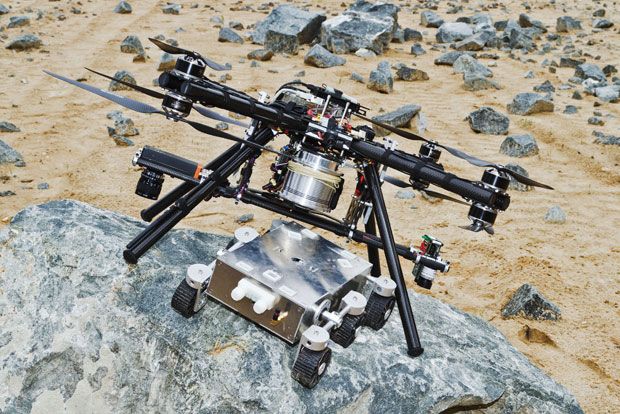The most ludicrous way of getting a robot to the surface of Mars is maybe stuffing it inside a giant inflatable bouncy ball and dropping it from a parachute. And that is only slightly more ludicrous than attaching it to a rocket-powered hovercrane (a rocket-powered hovercrane!!!) and thenlowering it to the ground with some sort of ridiculous cable contraption.
So, the bar is very high for finding ludicrous ways of getting robots to the surface of Mars, and the European Space Agency (ESA) has taken on the challenge with a quadcopter that can safely drop a rover down onto the Martian surface while hovering.
This is a combination of navigation software and hardware (GPS plus inertial systems, followed by vision-based navigation, a laser range finder, and a barometer), and visual hazard avoidance: the quadcopter is actively avoiding perceived obstacles (big pointy rocks and such) to find a nice, clear, flat, happy place to set down its rover cargo, using a 5-meter-long bridle.
You can think of this system as a combination of NASA's Morpheus lander, which has autonomous obstacle avoidance for landing site selection:
And this system from Japan, which is designed to deploy small rovers into (or next to) volcanoes:
Now, no matter what the ESA says in its press release, we don't want you to get the idea that this thing is now ready to fly off to Mars, rover in tow. There's a reason that NASA went with rockets and not rotors. I mean, there are probably lots of reasons, but one of them is that Mars doesn't have much atmosphere: the pressure at "sea level" on Mars (which is the average radius of the planet, Mars not currently being in possession of any seas) is about one-hundredth the atmospheric pressure at sea level on Earth.
And since things like helicopters depend on thrusting air downward to keep themselves up, you're going to need some ludicrously long blades (or a huge number of small ones) to physically move enough atmosphere to remain airborne. The reduced gravity (a little over a third of that on Earth) will help substantially, but it's still not a proven approach. This page from Georgia Techprovides more detail on how bad of an idea this is, and suggests flapping wings as a substitute (although I think it's research from 2001-ish).
What's most relevant here is the software that the team developed to navigate and detect hazards, because it can (presumably) be adapted to other flying platforms, like rocket cranes, or something more exotic, like maybe something based on a balloon. Or an anti-gravity hovership. The ESA has those, right?




No comments:
Post a Comment